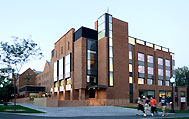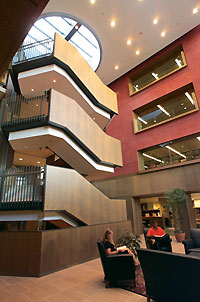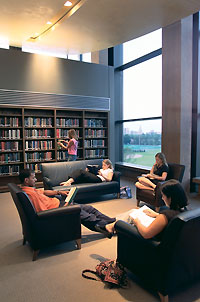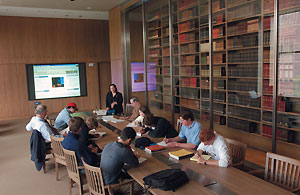Bricks & Clicks
The Evolution of the Raether Library
and Information Technology Center
by Steve Veshosky
photographs by Al Ferreira
 Few things in life are as rewarding as watching an idea develop
from concept to completion. For three longtime Trinity
administrators, just such an experience culminated in the October
2003 dedication of the Raether Library and Information Technology
Center. It was during a meeting of Henry DePhillips, John
Langeland, and Stephen Peterson in the early fall of 1995 that
the notion of permanently linking the library with the computing
center began to evolve. “We were discussing various ideas
that impact both the computing center and the library,”
DePhillips remembers, “and a light went on somewhere. We
just looked at each other for a moment and then someone said,
‘Wouldn’t it be great if those two facilities were
close to each other? In fact, what if they were merged into one?’”
The rest, as the saying goes, is history. Few things in life are as rewarding as watching an idea develop
from concept to completion. For three longtime Trinity
administrators, just such an experience culminated in the October
2003 dedication of the Raether Library and Information Technology
Center. It was during a meeting of Henry DePhillips, John
Langeland, and Stephen Peterson in the early fall of 1995 that
the notion of permanently linking the library with the computing
center began to evolve. “We were discussing various ideas
that impact both the computing center and the library,”
DePhillips remembers, “and a light went on somewhere. We
just looked at each other for a moment and then someone said,
‘Wouldn’t it be great if those two facilities were
close to each other? In fact, what if they were merged into one?’”
The rest, as the saying goes, is history.
 As the computer-driven technological revolution of the 1980s and
1990s advanced information and data management systems to new
levels of sophistication, library and information technology
professionals everywhere became increasingly aware of overlaps
between their respective areas of expertise. Those relationships,
while always important to both disciplines, became much more
crucial amid advancements in software applications and
increasingly widespread use of the Internet. DePhillips (Vernon
Krieble Professor of Chemistry and former interim dean of
faculty), Langeland (director of information technology), and
Peterson (associate academic dean and former college librarian)
were among those at Trinity who first recognized the direction in
which 21st century college libraries were headed. As the computer-driven technological revolution of the 1980s and
1990s advanced information and data management systems to new
levels of sophistication, library and information technology
professionals everywhere became increasingly aware of overlaps
between their respective areas of expertise. Those relationships,
while always important to both disciplines, became much more
crucial amid advancements in software applications and
increasingly widespread use of the Internet. DePhillips (Vernon
Krieble Professor of Chemistry and former interim dean of
faculty), Langeland (director of information technology), and
Peterson (associate academic dean and former college librarian)
were among those at Trinity who first recognized the direction in
which 21st century college libraries were headed.
Following their meeting, DePhillips “floated a trial
balloon” about the concept for a merged library and “learning
resource center” when he addressed the Trustees during their
October 1995 meeting. The Board was interested in the idea and
expressed a desire to know more. And so, at DePhillips’
urging, Langeland and Peterson drew up a detailed report,
including how other colleges were handling library upgrades and
what library science and information technology professionals
thought of the concept. “We knew we were heading in the
right direction,” explains Peterson. “And once we had
the support of the Trustees, and particularly the perspective of
Don McLagan, who was then a trustee and is an extremely
knowledgeable technology professional, things started to happen.”
Their report was subsequently presented to the Trustees during a
January 1996 meeting, at which point the board agreed to take up
a formal discussion of the plan.
 The College had already established a library advisory
committee as early as February 1991, charging it with
investigating the particulars of a major library renovation and
expansion. The College library, which holds nearly one million
volumes, more than 2,400 periodicals, and 624,800 other nonprint
materials, was originally built in 1952 and later expanded in
1978. The advisory committee, made up of faculty members and
students, reported their findings to the Strategic Planning
Committee of the Board of Trustees in the spring of 1992. While
illuminating Trinity’s need for a major library renovation
and expansion, the committee’s report also cemented the
library construction project as a priority of the College’s
capital campaign. The College had already established a library advisory
committee as early as February 1991, charging it with
investigating the particulars of a major library renovation and
expansion. The College library, which holds nearly one million
volumes, more than 2,400 periodicals, and 624,800 other nonprint
materials, was originally built in 1952 and later expanded in
1978. The advisory committee, made up of faculty members and
students, reported their findings to the Strategic Planning
Committee of the Board of Trustees in the spring of 1992. While
illuminating Trinity’s need for a major library renovation
and expansion, the committee’s report also cemented the
library construction project as a priority of the College’s
capital campaign.
For the serious purpose of scholarship
As the process moved forward, the project went through a number
of configurations in order to remain consistent with the campus
master plan. Eventually, the College settled on the
internationally acclaimed firm of Kuwabara Payne McKenna Blumberg
(KPMB) Architects of Toronto. According to KPMB partner-in-charge
Thomas Payne, “The Raether Library and Information
Technology Center was designed to invite students and faculty to
come together for the serious work of scholarship.” Included
among the numerous upgrades are an increase of more than 40
percent in total square footage and a 100 percent increase in
high-speed media access spaces. Named to honor the generosity of
Wendy and Paul E. Raether ’68, P’93, ’96, ’01,
the center’s completion integrates a host of computer and
media resources that were previously dispersed across campus,
while at the same time expanding the library into a building
suitable for a print collection of world renown.
 In addition to the library’s regular collections, the new
facility is home to the Watkinson Library, which boasts a rare
book collection of approximately 200,000 volumes and selected
manuscripts. The Raether Center also houses the Computing Center
and Media Technology Services. “Our students now have access
to the College’s computer network from practically anywhere
in the building,” explains Langeland. “This technology
provides a variety of advantages, from more efficient group
projects to the ability to download text and graphics from
virtually anywhere in the world.” In addition to the library’s regular collections, the new
facility is home to the Watkinson Library, which boasts a rare
book collection of approximately 200,000 volumes and selected
manuscripts. The Raether Center also houses the Computing Center
and Media Technology Services. “Our students now have access
to the College’s computer network from practically anywhere
in the building,” explains Langeland. “This technology
provides a variety of advantages, from more efficient group
projects to the ability to download text and graphics from
virtually anywhere in the world.”
Designed with an eye toward the future
College Librarian Richard S. Ross, who came to Trinity from
Georgetown University in 2000, immediately recognized the
benefits of a combined technology center and library. “The
significance to the College of a first-class media and
information technology center cannot be overstated,” Ross
says. “We now have a centrally located facility that is
truly the academic heart of the campus. Our students and faculty
now have access to a state-of-the-art research center.”
Upgrades and renovations to the building have also brought a need
for additional technologically savvy staff members, in order to
guide students and faculty through the facility’s enhanced
high-tech possibilities. The library and academic computing
staffs have collaborated on a number of initiatives, and staff
members are available to offer their expertise to ensure that the
College community is able to take full advantage of the Raether
Center’s new resources. “Our people have responded
remarkably well to these changes,” offers Ross. “As the
technology changes, our staff has to adapt. We need to make sure
that we keep abreast of all the latest available technology.”
One way to do that, Ross suggests, would be to create an endowed
fund for library science and information technology staff
development. “It’s imperative that we stay on top of
industry advances so that we can, in turn, pass that knowledge on
to students and faculty members,” he says.
 The Raether Center was designed to remain adaptable to
technological advances. In addition to completely rewiring the
older sections of the building, the renovation and expansion
project includes floors, ceilings, and wall panel structures that
are amenable to upgrades. “Flexibility is key in a building
like this,” says Langeland. “This facility was designed
with an eye toward the future.” The Raether Center was designed to remain adaptable to
technological advances. In addition to completely rewiring the
older sections of the building, the renovation and expansion
project includes floors, ceilings, and wall panel structures that
are amenable to upgrades. “Flexibility is key in a building
like this,” says Langeland. “This facility was designed
with an eye toward the future.”
Old books/new technology
back to top
|